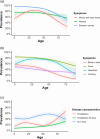Genomic and clinical characteristics of campylobacteriosis in Australia
- PMID: 38214338
- PMCID: PMC10868609
- DOI: 10.1099/mgen.0.001174
Genomic and clinical characteristics of campylobacteriosis in Australia
Abstract
Campylobacter spp. are a common cause of bacterial gastroenteritis in Australia, primarily acquired from contaminated meat. We investigated the relationship between genomic virulence characteristics and the severity of campylobacteriosis, hospitalisation, and other host factors.We recruited 571 campylobacteriosis cases from three Australian states and territories (2018-2019). We collected demographic, health status, risk factors, and self-reported disease data. We whole genome sequenced 422 C. jejuni and 84 C. coli case isolates along with 616 retail meat isolates. We classified case illness severity using a modified Vesikari scoring system, performed phylogenomic analysis, and explored risk factors for hospitalisation and illness severity.On average, cases experienced a 7.5 day diarrhoeal illness with additional symptoms including stomach cramps (87.1 %), fever (75.6 %), and nausea (72.0 %). Cases aged ≥75 years had milder symptoms, lower Vesikari scores, and higher odds of hospitalisation compared to younger cases. Chronic gastrointestinal illnesses also increased odds of hospitalisation. We observed significant diversity among isolates, with 65 C. jejuni and 21 C. coli sequence types. Antimicrobial resistance genes were detected in 20.4 % of isolates, but multidrug resistance was rare (0.04 %). Key virulence genes such as cdtABC (C. jejuni) and cadF were prevalent (>90 % presence) but did not correlate with disease severity or hospitalisation. However, certain genes (e.g. fliK, Cj1136, and Cj1138) appeared to distinguish human C. jejuni cases from food source isolates.Campylobacteriosis generally presents similarly across cases, though some are more severe. Genotypic virulence factors identified in the literature to-date do not predict disease severity but may differentiate human C. jejuni cases from food source isolates. Host factors like age and comorbidities have a greater influence on health outcomes than virulence factors.
Keywords: Campylobacter; antimicrobial resistance; clinical outcomes; severity; virulence; whole genome sequencing.
Conflict of interest statement
The author(s) declare that there are no conflicts of interest.
Figures




References
-
- Australian Government Department of Health and Aged Care National Notifiable Disease Surveillance System - National Communicable Disease Surveillance Dashboard. 2023. https://nindss.health.gov.au/pbi-dashboard/
-
- Centers for Disease Control and Prevention FoodNet Fast - Pathogen Surveillance 2022. https://cdc.gov/foodnetfast/ n.d.
MeSH terms
Substances
LinkOut - more resources
Full Text Sources
Medical
Molecular Biology Databases
Miscellaneous

